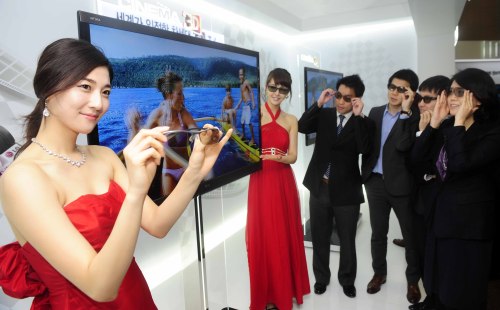LG Electronics on Wednesday unveiled its first 3-D television using film-type patterned retarder panels that it claimed have effectively eliminated problems with the current 3-D technology.
The Seoul-based electronics firm said in a press conference that the current shutter glass panels have serious limitations such as flickering and cross talk ― blurry ghosting images ― that viewers have persistently complained of.
Noting the improvements, LG Electronics said 80 percent or more of the 3-D TVs it produces would be for its latest Cinema 3-D TV lineup.
It also predicted that its newest film-type patterned retarder technology, also known as FPR, would dominate the 3-D TV market.
“FPR will eventually rise to become the second generation of 3-D technology,” Kwon Hee-won, executive vice president of the firm’s Home Entertainment division, told reporters to indicate that shutter glass was the outgoing first generation.
 |
LG Electronics unveils a new 3-D television on Wednesday. (Chung Hee-cho/The Korea Herald) |
Samsung Electronics, the world’s largest TV-maker, still uses shutter glass technology for its 3-D TVs.
Kwon predicted that up to 80 percent of all 3-D TVs it plans to sell would use FPR technology.
The firm said its biggest focus was on creating a comfortable viewing experience.
“We have added the human factor to make sure that our products give our customers an easier and more convenient viewing experience,” said Ro Seog-ho, senior vice president of LG Electronics’ Home Entertainment division.
LG also said 90 percent of its LCD TVs will consist of sets using either 3-D or smart technology.
Cinema TVs offer full 3-D vision regardless of where the viewer stands or sits in front of the set, which contrast with existing 3-D TVs that provide 3-D vision only when the viewer sits directly in front of the set.
Another strong point of the film-type patterned retarder technology is in the special eyewear that all 3-D vision requires.
As LG’s latest 3-D lineup is able to completely realize 3-D vision without the aid of the glasses, which was the case with existing 3-D technology, customers will be able to see 3-D without the heavy, clunky glasses that shutter glass technology required.
The new glasses also do not require batteries and are aesthetically more pleasing and lighter in weight.
LG’s new 3-D lineup is to be sold globally within the first quarter of this year.
In total, the company hopes to sell around 40 million flat-panel TVs this year to secure a 16 percent market share and reduce the gap with top player Samsung.
In the high-end global TV market consisting of mostly smart TVs and 3-D TVs, LG is aiming to carve out a 20 percent share, Kwon said.
By Kim Ji-hyun (
jemmie@heraldcorp.com)







![[Today’s K-pop] Blackpink’s Jennie, Lisa invited to Coachella as solo acts](http://res.heraldm.com/phpwas/restmb_idxmake.php?idx=644&simg=/content/image/2024/11/21/20241121050099_0.jpg)
